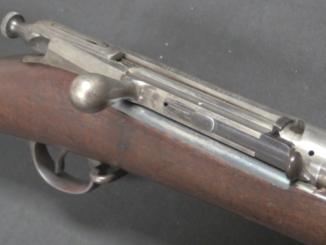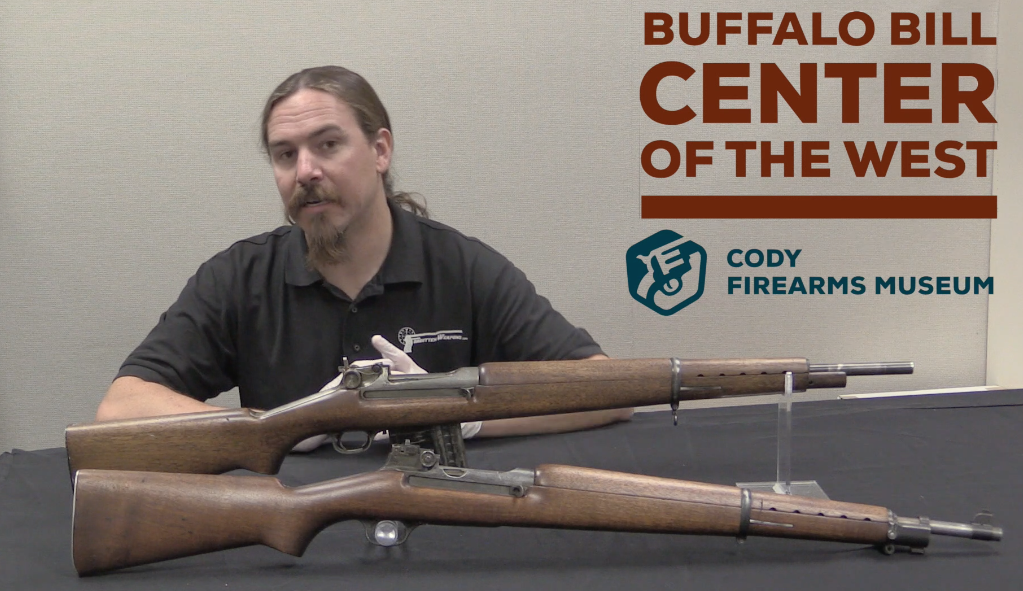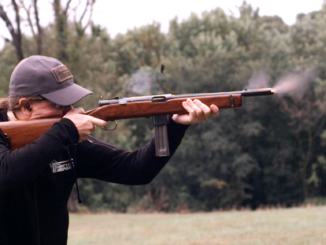John and James Miller of Rochester New York designed and built this rifle, which is an example of an intermediate revolving firearm. It comes after the flintlock Collier guns, but before Sam Colt’s Paterson demonstrated how to use the hammer to automatically index the cylinder. Miller’s gun (it was actually patented by James Miller, in 1829) requires the cylinder to be manually rotated between shots, and uses a pill lock ignition system. Each chamber in the cylinder has a small recess into which a pill of explosive mercury fulminate can be seated and sealed in place with beeswax. The firing pin on the hammer crushes the pill upon firing, creating the sparks to ignite the gunpowder charge in the chamber.
Only a few hundred of these rifles were made, between 1835 and 1850. They were constructed by about a half dozen different gunsmiths, with the most common being Billinghurst (a man who had worked with the Miller brothers).




I wonder how the mercury fulminate was handled and stored. This would be a major hazard. It is sensitive to both compression and temperature. If I remember correctly, it ignites spontaneously at 60 degrees Celcius and burns at 300 meters per second.
Pill lock priming compound more often was based on potassium chlorate than mercury fulminate. It was generally mixed about 3-to-1 with “sulphuret of antimony” (antimony disulfide /trisulfide), with some “gum arabic” (acacia sap gum)to hold it together and render it somewhat water-resistant. The combination is not unlike that found on the head of a modern strike-anywhere match; the pale blue part of a typical “blue tip” match is mostly Sb2S3.
While safer to handle than mercury(II) fulminate aka Hg(CNO)2, generally letting the pills rub together in a container was considered inadvisable.
cheers
eon
Thanks. This makes more sense…and happier.
Cheers,
Hugo
William Billinghurst had a rather interesting career on his own, as well. Besides making revolving arms, he was noted for his heavy-barreled “benchrest” rifles, some of which were used as snipers’ rifles in the American Civil War.
And during the war, he went into business with a doctor named Josephus Requa (his former apprentice-?), to make the “Billinghurst/Requa Battery Gun”, also known as the “covered bridge gun”;
https://en.wikipedia.org/wiki/Billinghurst_Requa_Battery
Contrary to popular belief, they were not common weapons in the ACW, although they were used (over the strenuous objections of several “old school” senior Union officers) at the sieges of Petersburg and Richmond.
As an interesting side note, William Billighurst also held a patent for one of the earliest patterns of spincasting fishing reel.
😉
cheers
eon
“As an interesting side note, William Billighurst also held a patent for one of the earliest patterns of spincasting fishing reel.”
So far I know, there are several people, that lived in 19th century, now mostly remembered for fire-arm designing, but that were actively developed also different machines.
For example Christopher Miner Spencer (in context of American Civil War: designer of Spencer repeating rifle) also developed the first fully automatic turret lathe (according to his query in Wikipedia)
sir Hiram Maxim (in context of Age Of Imperialism: inventor of Maxim machine gun) also was developing heavier-than-air flying machine and patented mousetrap
Hugo Borchardt (that designed C-93 pistol) patented MEANS FOR HOLDING PLATINUM SPONGES IN AUTOMATIC GAS LIGHTERS. (Patent US 594377 A from 1897)
Christopher Spencer’s greatest contribution was his collaboration with Herman Hollerith.
Hollerith had developed a tabulating machine while working for the U.S. Census Bureau that allowed the 1890 Census to be completed in half the time of the 1880, while counting nearly twice as many people.
He and Spencer went into business making tabulators and adding machines under the name Business Machines, Inc. in 1904.
Just before his death in 1924, Spencer added “International” to the firm’s name.
Yes. Christopher Spencer, inventor of the Spencer repeating rifle, was the co-founder of IBM.
cheers
eon
There is a good reason percussion caps were developed. Carrying pills of unstable explosive compounds in your pocket would not be much safer than juggling bottles of nitroglycerin… I could be wrong, but I’d rather have the percussion caps in the proper box than pills of primer.
“I’d rather have the percussion caps in the proper box than pills of primer”
For technology alternative to “pills” and alternative to “percussion cap” see Maynard tape: https://en.wikipedia.org/wiki/Maynard_tape_primer